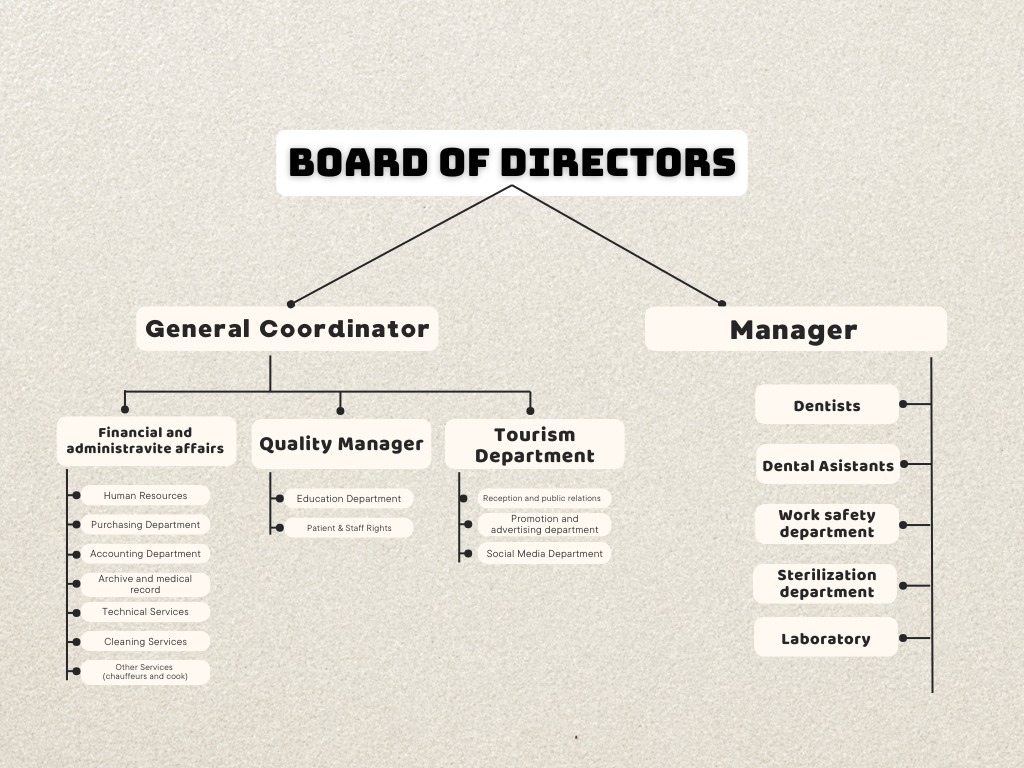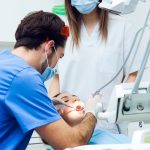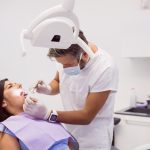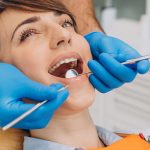INSTITUTIONAL

– We consider patient and employee safety as a vital part of our corporate culture.
– We always adhere to ethical values.
– We adopt a fair, equitable and scientific approach in all our services.
– We work with a team approach.
– We always aim for patient and employee satisfaction.
– We are sensitive to the environment by respecting sustainable practices.
– We aim to make a difference with an innovative and contemporary approach.
– We are always effective, transparent and reliable.
– We aim to develop and improve our services by focusing on the development of our employees.
It is the quality policy of Private DOC Oral and Dental Health Polyclinic, which provides Oral and Dental Health Services by prioritizing patient satisfaction.
We ensure that patient satisfaction is prioritized by fulfilling the following conditions:
Creating Quality Targets, Creating Action Plans for These Targets and Ensuring that the Targets are Reviewed Annually.
Acting in Accordance with Our Strategic Targets We Have Realized in Line with Our Institutional Goals.
Fulfilling Quality Standards in Healthcare, and Ensuring Their Continuity.
Aiming for Continuous Improvement in Order for the Effective Sustainability of the Quality Management System. Sustaining Effectiveness with Corrective and Preventive Activities.
To fully understand patient requests and expectations, to be sensitive about service quality and proper implementation of work processes by determining them in the best way, to approve and adopt them,
To develop our processes according to technological innovations,
To continuously improve the work done,
To comply with SKS (Health Quality Standards) requirements
To ensure that our employees understand our Quality Policy and goals and to ensure that our employees participate in the system with the awareness of their duties and responsibilities during the maintenance phase, to ensure communication within the Private DOC Oral and Dental Health Polyclinic.
To review the quality policy in the management review meetings as planned, To demonstrate our control over our processes by applying the disciplines required by the Health Quality Standards and to build trust within the organization and towards our patients and to demonstrate that quality requirements are fulfilled by our Clinic.
Purpose:
The ethical rules have been prepared to determine the professional behavior standards of all personnel working in the polyclinic, to protect patient rights and to create a reliable and respectful working environment.
Ethical Rules:
2.1. Patient Rights and Safety
Patients are always treated respectfully, kindly and fairly.
Patient information is kept confidential and shared only within the framework of legal permission.
All patients are provided with accurate, clear and understandable information to ensure that they make informed decisions.
Practices that may endanger patient safety during treatment are avoided.
2.2. Professionalism and Honesty
All procedures are carried out in accordance with legal regulations, professional standards and scientific truths.
Patient needs are prioritized in treatments; unnecessary or unethical practices are avoided.
Employees undertake to continuously improve their professional competence.
2.3. Intra-Team Relations and Work Environment
All employees treat each other respectfully, fairly and cooperatively.
Any discrimination (gender, religion, language, race, etc.) is strictly prohibited.
Unprofessional and unethical behavior is not tolerated in the work environment.
2.4. Conflicts of Interest and Acceptance of Gifts
Employees avoid conflicts of interest in their relationships with patients or suppliers.
No gifts, financial gains or advantages are accepted from patients or suppliers.
2.5. Information and Records Management
Patient files, treatment reports and all other documents are prepared accurately and completely.
Patient information is shared only in accordance with legal and ethical requirements.
2.6. Social Responsibility and Environmental Awareness
Polyclinic services are provided in a way that improves public health.
Environmentally sensitive practices are adopted and waste management rules are followed.
2.7. Transparency and Accountability
Patients are provided with clear information about treatment processes, pricing and possible outcomes.
Each employee accepts that they are responsible for their own actions and decisions.
Ethical Violations and Sanctions:
In case of violation of ethical rules, the necessary disciplinary processes are initiated depending on the nature of the incident.
Violations are evaluated by the management or ethics committee and legal action is taken if necessary.
Implementation of Ethical Rules:
Ethical rules are explained in detail to all employees during the recruitment process.
Employees are made aware of ethical issues through regular training.
Each employee undertakes in writing that they accept ethical rules.
Monitoring and Updating:
Ethical rules are reviewed regularly and updated when necessary.
Rules are improved by taking into account feedback from employees.
These ethical rules support DOC Oral and Dental Health Clinic to adopt a reliable and patient-focused service approach.
The provision of health services is a team effort. In traditional health service provision, the physician was the most effective. In the contemporary service approach, since it is not sufficient on its own, it has been adopted that these services should be provided together with people who have received training in various subjects related to health. Each health worker, who is a part of this team, has certain rights that we will list below, just like patients. These rights are listed below.
1. The Right of Physicians/Health Workers to Receive a Quality Education and Renew Themselves Due to the rapid development of medical science, the vital importance of the service area and the high risk, they should be trained with an effective, high-quality and constantly renewing education approach. In addition, after completing their education, they should follow current developments and ensure that their knowledge is refreshed and developed with in-service training, conferences and seminars. This is one of their most fundamental rights.
2. The Right of Physicians to Apply Contemporary Scientific Medical Opportunities The medical profession now needs communication and computer technology in parallel with developing technology. It is the right of a physician who is introduced to the application areas of high technology in medicine in medical education to want to experience these developments in diagnosis and treatment in his/her professional life.
The aim here is to provide services in line with current developments by establishing a step-by-step health service and operating the referral process in line with the possibilities of each society and country.
3. The Right of Physicians/Healthcare Workers to Adhere to Ethical Principles While Practicing Their Profession
While performing their duties, both the medical profession and other health care personnel are obliged to provide services with the sensitivity and seriousness required by their profession and by adhering to ethical principles. They encounter many ethical dilemmas while practicing their profession. These may be political, cultural, social and economic values. Therefore, they have the right to provide services with the awareness of responsibility required by their profession and without being affected by anything and by adhering to ethical rules.
4. The Right of Physicians and Healthcare Workers to Practice Their Profession Without Being Under Pressure Any kind of pressure or restriction of freedom that may occur while practicing the profession contradicts the nature of the profession. However, both physicians and healthcare professionals start their profession by swearing to serve all people equally without discrimination. Therefore, political, social and physical pressures are never acceptable. They have the right to provide service without being affected by anything and without being pressured within the framework of their professional responsibilities.
5. The Right of Physicians and Healthcare Professionals to Avoid Situations Contrary to Their Values Healthcare services are services provided within the framework of certain principles and guidelines. The patient-physician/healthcare professional relationship is shaped by the principle of respecting certain values. A healthcare professional cannot request a service that contradicts their own values. The healthcare professional can defend their own values in a way that does not create a negative impact on their duties.
6. The Right of Physicians and Healthcare Professionals to Protect Their Own and Their Families' Healthcare services inherently carry many risks. Healthcare professionals are exposed to many diseases or work accidents while performing their duties. Some of these can be fatal or cause disabilities. Therefore, healthcare professionals have the right to request to work in conditions where these risks will be minimized.
7. The Right of Physicians/Healthcare Workers to Request an Adequate Income Level Considering the risks involved in healthcare services, as well as the long and arduous nature of the medical profession, their services should also be paid fairly and justly.
8. The Right of Physicians/Healthcare Workers to Participate in Administrative Processes They have the right to take part in administrative processes related to the institutions they are in and the country, or to express their opinions on health-related legislation.
9. The Right to Withdraw from Testimony Physicians may refrain from testifying due to professional secrets they have learned about patients. (CMK. Art. 46) When physicians disclose these secrets (information) without permission, they commit the crime of disclosing professional secrets. If the physician is going to exercise this right, they submit a petition before the hearing and notify the court of the situation. However, in criminal cases, they must attend the hearing and state that they will exercise this right.
10. Emergency Services with the Hızır Ambulance System If a doctor does not go to the patient in an emergency, he/she is found guilty of causing death by negligence. With the rapid development of technology and transportation facilities, it is necessary to create emergency ambulance/transportation systems that can reach the relevant places (homes, workplaces, etc.) in such cases. In this way, doctors do not leave the institution where they provide service unnecessarily and the continuity of the service is ensured.
11. The Right of the Doctor to Refuse a Patient In public and other legal institutions, doctors do not have the right to refuse a patient. Even if the doctor works in a private institution,
The additional physician must accept the patient. In disasters such as earthquakes, wars, and floods, the physician must look after all patients. However, except for the fulfillment of official or humanitarian duties, the physician may not look after the patient for professional or personal reasons (Medical Deontology Regulation, Article 18).
12. The Physician's Right to Consultation/Ask for Consultation The medical profession has now shifted from being a sole decision-maker to being a "member of a team that makes decisions". The physician has the right to consult or seek advice whenever needed.
13. The Right Not to Guarantee Recovery A contract is made between the patient who comes for treatment and the physician. Therefore, the physician finalizes the treatment he/she has started, completes the deficiencies, and monitors the patient until he/she recovers. The physician is not obliged to guarantee complete recovery in this contract. (Except for dental, aesthetic surgery, and orthopedic prostheses) He/she makes the diagnosis in accordance with scientific requirements and applies the necessary treatment. He/she cannot be criticized because the result does not result in cure (TDT, Article 13).
14. The Right to Allocate Sufficient Time to Patients
A physician is expected to show the necessary care to his patient, record information and documents well, and inform the patient about his/her illness. A physician needs detailed time to provide these to his/her patient. According to Article 10 of the Medical Specialization Regulation, “In each service, a specialist cannot see more than 20 patients per day in a normal polyclinic. However, if more patients apply, another physician is assigned”. It is a general acceptance that a physician should allocate at least 20 minutes to his/her patient. Because a physician wants to conduct a detailed examination in order to be useful to his/her patient, and this is his/her most natural right.
15. The Right to Choose the Treatment Method
If there is more than one method in the treatment of diseases, the physician is free to choose the one he/she wants (TDT 6.m). However, he/she should choose the most well-known and proven reliable one. In addition, physicians have the right to request that the drugs and recommendations they recommend to the patient for treatment be followed. Physicians' Obligations Physicians are obliged to respect their patients' health, personality, and rights arising from domestic and international law. Physicians are expected to have the knowledge and experience required by the medical profession, to show sufficient care and attention while practicing their profession, and to act in accordance with the law and ethical rules. A physician who works with great devotion to improve the health of his patient must also act flawlessly in terms of the law and be well aware of his duties, authorities and responsibilities in order to be protected from unfair accusations. Therefore, the physician/healthcare professional must obtain Informed Consent (Assent) for the legality of the medical intervention, not perform medical interventions that are considered crimes by law, have appropriate and sufficient conditions (team, equipment, tools, equipment) for the medical intervention, choose an appropriate and valid medical method, have the extent of the medical intervention compatible with the consent, record all medical interventions for diagnosis and treatment, and have written consent for major surgical interventions. Verbal consent may be sufficient for simple interventions, but this is difficult to prove. Medical records and their confidentiality for the patient are a legal obligation. They are of great importance in terms of the patient's treatment and follow-up. They form the basis for the preparation of forensic reports. In cases where there is a claim of medical fault, they are of great importance in the defense of the physician.
Short-Term Goals (0-1 Years)
1.1. Patient Satisfaction and Service Quality
Purpose: To improve the experience of patients visiting the clinic.
Purposes:
Conducting a satisfaction survey for each patient.
Implementing rapid corrective actions based on patient feedback.
Increasing the use of the online appointment system.
Conducting advertising activities abroad
1.2. Marketing and Patient Growth
Purpose: Increasing new patient acquisition.
Purposes:
Starting social media and Google Ads campaigns.
Promoting the website and online reservation system.
Offering special campaigns to nearby schools, workplaces and sports centers.
1.3. Technological Infrastructure Improvements
Purpose: Digitalizing and accelerating the clinic's operations.
Purposes:
Updating or digitizing the appointment and patient management system.
Increasing efficiency by transferring patient records to a digital environment.
Medium-Term Goals (1-3 Years)
2.1. Clinic Reputation and Professional Development
Purpose: To ensure that the clinic is known as a respected institution in its field.
Goals:
Organizing training programs for dentists and healthcare personnel.
Developing the skills of the staff by organizing in-clinic seminars and workshops.
Collaborating with local healthcare institutions and universities.
2.2. Expanding the Patient Portfolio
Purpose: To increase the diversity and number of patients of the clinic.
Goals:
Organizing special campaigns on family and child dental health.
Increasing the variety of services in specialty areas such as orthodontics and aesthetic dentistry.
Offering special health packages to company employees by making corporate agreements.
Publishing advertisements abroad and increasing the scope and visibility of these advertisements.
2.3. Financial Sustainability and Investments
Purpose: To ensure financial sustainability of the clinic and prepare the infrastructure for growth.
Goals:
Increasing the profit margin by keeping costs under control.
Investing in new dentistry technologies (e.g. 3D printers, digital x-ray devices).
To receive financial consultancy that will provide maximum benefit in tax and legal obligations.
Long-Term Goals (3-5 Years)
3.1. Opening a New Branch and Expansion
Purpose: To increase the regional presence of the clinic.
Goals:
To start research to open a new branch in the city.
To spread innovative services that make a difference in the field of dentistry to other regions.
To create a growth strategy by researching franchise or business partnership models.
To open new branches abroad.
3.2. Establishing a Fully Equipped Dental Health Center
Purpose: To expand dental health services and establish a larger, fully equipped center.
Goals:
To improve patient treatment processes using modern medical devices and digital technologies.
To evaluate health tourism opportunities and attract international patients.
3.3. Developing Corporate and Social Reputation
Purpose: To make the clinic a socially accepted and recognized institution.
Goals:
To organize free seminars and dental screenings to increase public health awareness.
To achieve “green clinic” status by adopting environmentally friendly practices.
To take part in industry journals and scientific publications and share clinical success stories.
- Purpose:
To systematically conduct the risk management process, identify, analyze and control the risks that the clinic may encounter.
- Scope:
This risk registry covers all clinical, administrative and support processes of the DOC Oral and Dental Health Clinic.
- Risk Registry Format:
The risk registry should include the definition of each risk, probability, impact level, control measures taken and the responsible person/team.
| Risk No | Risk Category | Risk Definition | Probability (1-5) | Impact (1-5) | Risk Level (Probability x Impact) | Control Measures | Responsible Person/Team |
| 1 | Clinical | Infection due to lack of sterilization risk | 1 | 5 | 5 | - Regular control of sterilization devices - Organization of training programs - Weekly hygiene inspection | Clinical hygiene team |
| 2 | Patient Safety | Implementation of incorrect treatment | 1 | 5 | 5 | - Regular control of patient files - Implementation of double-check system - Strengthening physician-patient communication | Treatment planning team |
| 3 | Administrative | Reputation damage due to patient dissatisfaction loss | 1 | 2 | 2 | - Regular analysis of survey results - Improvement of complaint management process | Patient Rights team |
| 4 | Technological | Digital patient record system crash | 1 | 5 | 5 | - Regular backups - IT team prepared for possible failures | IT support team |
| 5 | Financial | Incorrect collection of treatment fees | 2 | 2 | 4 | - Updating automatic payment systems - Accounting audit | Finance department |
| 6 | Employee Safety | Employee injuries from sharp objects | 1 | 1 | - Safe storage of sharp objects - Providing protective equipment - Occupational health and safety training | Occupational Health and Safety Committee | |
| 7 | Legal | Legal processes | 1 | 5 | 5 | - Filling out patient information forms correctly - Recording all transactions | Legal and management team |
| 8 | Environmental | Treatment interruption due to power outage | 1 | 2 | 2 | - Use of generators - Creation of emergency plan | Technical team |
| 9 | Emergency | Fire | 1 | 5 | 5 | - Checking fire detectors and extinguishers - Regular fire drills | Emergency team |
| 10 | Education | Employees not learning new treatment methods | 2 | 3 | 6 | - Making annual training plans - Allocating budget for training programs | Training coordinator |
- Risk Level Calculation:
- Low Risk: 1-5
- Medium Risk: 6-10
- High Risk: 11-15
- Critical Risk: 16-25
- Risk Management Plan:
- Monitoring of Risks: Those with high risk levels are monitored with priority.
- Update: The risk register is reviewed annually and updated when necessary.
- Responsibility: The team and person designated for each risk are responsible for monitoring the process.
Strengths
- Experienced Staff: Presence of expert dentists and health professionals.
- Modern Equipment: Use of the latest technology dental treatment equipment and devices.
- High Customer Satisfaction: Positive feedback and high satisfaction rates among patients.
- Good Location: The clinic is in an easy location for transportation.
- Various Services: Offering a wide range of services such as dentistry, orthodontics, implants.
- Weaknesses
- Limited Marketing: Inadequate marketing and advertising strategies.
- High Costs: Treatment costs are high for some patients.
- Frequent Staff Change: Frequent staff changes can affect service continuity.
- Low Online Presence: Insufficient content and interaction on social media and website.
- Opportunities
- Entering New Markets: Potential to open new branches in local areas.
- Digital Marketing: Opportunity to reach a wider audience through social media and digital advertising.
- Service Variety: Offering new treatment methods and services (e.g., aesthetic dentistry).
- Increasing Health Awareness: Increasing interest in oral and dental health in society increase.
- Threats
- Increased Competition: Opening of new dental clinics and increased competition.
- Economic Recession: Economic difficulties reduce patient interest in treatment.
- Legal Regulations: Effects of new legal regulations regarding health services.
- Pandemic Effects: Negative effects on clinic activities due to health crises experienced in the past.
The personnel are provided with training on issues such as environment, energy, natural resources, air emission, finance, economy etc. and these have been determined as company policy.
In this way, we contribute to a cleaner, more prosperous and permanent future and a more conscious society.
Some of the projects we have implemented are:
Providing training to the personnel on Environment and Waste Management.
Storing Paper, Glass, Plastic, Battery and Medical Waste in separate boxes.
Sending the waste to the relevant institutions for recycling.
Including the Energy Certificate article in the purchasing specifications.
Examining the products and preferring the ones that are economical and environmentally friendly.
Preferring the patient transfer vehicles with relatively low fuel consumption and emissions.
Providing training to encourage the personnel to save.
Taking precautions against economic, political, global, disaster etc. risks.
Opinion And Your suggestion










